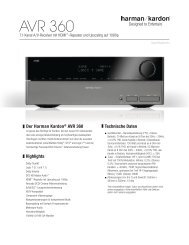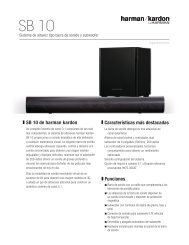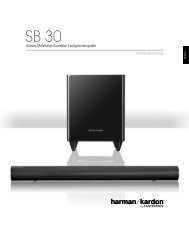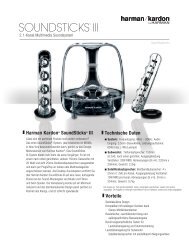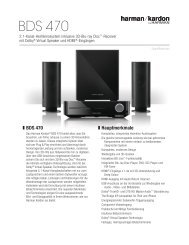Owner Manual - AVR 158 (English EU) - Harman Kardon
Owner Manual - AVR 158 (English EU) - Harman Kardon
Owner Manual - AVR 158 (English EU) - Harman Kardon
You also want an ePaper? Increase the reach of your titles
YUMPU automatically turns print PDFs into web optimized ePapers that Google loves.
<strong>AVR</strong> <strong>158</strong><br />
Types of Home Theatre System Connections<br />
there are different types of audio and video connections used to connect the AVr to your<br />
speakers, your tV or video display, and your source devices. the consumer electronics<br />
Association has established the ceA ® colour-coding standard.<br />
Connection Colour Guide Table<br />
Analogue Audio Connection Colour<br />
Front left/right white/red<br />
centre green<br />
Surround left/right blue/gray<br />
Subwoofer purple<br />
Digital Audio Connection Colour<br />
coaxial (input or output) orange<br />
optical Input black<br />
Analogue Video Connection Colour<br />
component Video red/green/blue<br />
composite Video Yellow<br />
Speaker Connections<br />
Speaker cables carry an amplified signal from the AVr’s speaker terminals to each<br />
loudspeaker. each cable contains two wire conductors, or leads, that are differentiated<br />
in some way, such as with colours or stripes.<br />
the differentiation helps you maintain proper polarity, without which your system’s lowfrequency<br />
performance can suffer. each speaker is connected to the AVr’s speakeroutput<br />
terminals using two wires, one positive (+) and one negative (–). Always connect<br />
the positive terminal on the speaker, which is usually coloured red, to the positive<br />
terminal on the AVr, which is coloured as indicated in the connection colour guide<br />
table, above. the negative terminals on the speakers and the AVr are black.<br />
Your AVr uses binding-post speaker terminals that can accept bare-wire cables or<br />
banana plugs. bare-wire cables are installed as shown below:<br />
1. unscrew cap 2. Insert bare wire 3. tighten cap<br />
banana plugs are inserted into the hole in the middle of the terminal cap, as shown<br />
below:<br />
A. tighten cap b. Insert banana connector<br />
into hole in cap<br />
Always connect the coloured (+) terminal on the AVr to the (+) terminal on the speaker<br />
(usually red), and the black (–) terminal on the AVr to the (–) terminal on the speaker<br />
(usually black).<br />
IMPORTANT: Make sure the ( + ) and ( – ) bare wires do not touch each other or<br />
the other terminal. Touching wires can cause a short circuit that can damage your<br />
<strong>AVR</strong> or amplifier.<br />
Types of Home Theatre System Connections<br />
Subwoofer Connections<br />
the subwoofer is a speaker dedicated to reproducing only the low (bass) frequencies,<br />
which require more power. to obtain the best results, most speaker manufacturers offer<br />
powered subwoofers that contain their own amplifiers. use a single rcA audio cable<br />
(not included) to make a line-level (non-amplified) connection from the AVr’s Subwoofer<br />
connector to a corresponding input jack on the subwoofer.<br />
Although the AVr’s purple subwoofer output looks similar to a full-range analogue audio<br />
jack, it is filtered so that only the low frequencies pass through it. don’t connect this<br />
output to any device other than a subwoofer.<br />
Source Device Connections<br />
Audio and video signals originate in source devices (components where a playback<br />
signal originates) such as your blu-ray disc or dVd player, cd player, dVr (digital video<br />
recorder) or other recorder, tape deck, game console, cable or satellite television tuner<br />
or Mp3 player. the AVr’s FM/AM tuner also counts as a source, even though no external<br />
connectors are needed other than the AVr’s FM and AM aerials. Separate connectors are<br />
required for the audio and video portions of the source device’s signal, except for digital<br />
hdMI connectors. the types of connectors you use will depend upon the capabilities of<br />
the source device and of your tV or video display.<br />
Digital Audio Connections – HDMI<br />
there are two types of audio connections – digital and analogue. digital audio signals<br />
are required for listening to sources encoded with digital surround modes, such as dolby<br />
digital and dtS, or for uncompressed pcM digital audio. Your AVr has three types of<br />
digital audio connectors: hdMI, coaxial and optical. do not use more than one type<br />
of digital audio connector for each source device. however, it’s okay to make both<br />
analogue and digital audio connections to the same source.<br />
Your AVr is equipped with four rear-panel hdMI input connectors and one hdMI monitor<br />
output connector. hdMI technology enables digital audio and video information to be<br />
carried using a single cable, delivering the highest quality picture and sound. If your tV<br />
or video-display device has an hdMI input connector, make a single hdMI connection<br />
from each source device to the AVr. usually, a separate digital audio connection is not<br />
required.<br />
the hdMI connector is shaped for easy plug-in (see illustration, below), and hdMI cable<br />
runs are limited to about 10 feet (3m). If your video display has a dVI input and is<br />
hdcp-compliant, use an hdMI-to-dVI adapter (not included), and make a separate audio<br />
connection.<br />
Digital Audio Connections – Coaxial<br />
coaxial digital audio jacks are usually colour-coded orange. Although they look like<br />
standard rcA-type analogue jacks, you should not connect coaxial digital audio outputs<br />
to analogue inputs or vice versa.<br />
11<br />
ENGLISH



